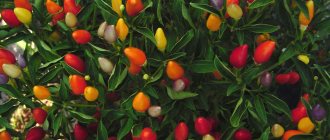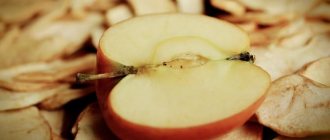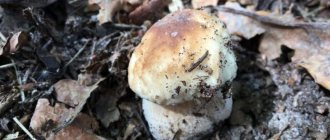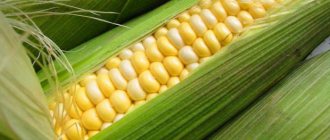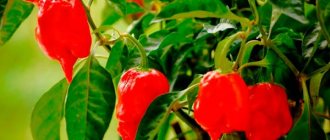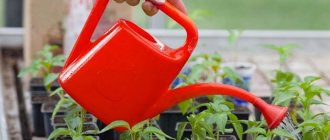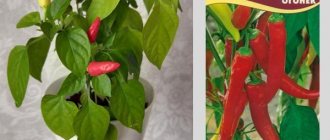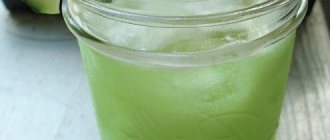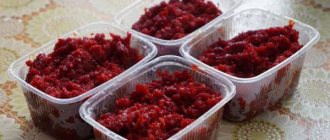Plant from ancient legends
Habanero is part of the chili pepper family and ranks first among them in terms of heat.
If we talk about all peppers, there are hotter varieties, but there are very few of them. Those who can stand the fiery taste of habanero experience fruity citrus notes and a delicate, floral aroma. There are not many people who dare to try raw habanero.
There is a legend in Mexico: the Aztecs offered those who were going to be sacrificed an alternative - to drink two glasses of tincture from this pepper. Few agreed.
Nowadays no one is sacrificed, but the vegetable remains iconic. And if tourists in Mexico order a dish with this pepper, the locals will respect them.
You don't have to fly to distant countries to taste habanero. You can grow it at home: either in the garden or in an apartment in a pot.
Some gardeners plant habanero not even for its hot peppers, but as an ornamental plant. It is very beautiful: shiny green leaves, like bright fruits, resemble hearts.
Origin of the Habanero Pepper
The pepper got its name from the Cuban capital, Havana. But there may also be a scientific name - “capsicum chinensis”, which was given to it in the 18th century. by the Austrian botanist N. Jacquin. During his trip to the West Indies, the scientist found an incredibly bright and beautiful vegetable, but was sure that it was brought from China to America.
The Habanero pepper is native to the Yucatan Peninsula (Mexico) and the Caribbean Islands. In ancient times, the Mayans and Incas used hot fruits both for cooking and for various rituals. After Columbus discovered America, this variety gradually began to conquer Eurasia and today is widely grown throughout the world.
Mexican pepper is a tropical plant, but if the right conditions are created, it can be successfully grown in our regions. Quite often, Habanero is used as an ornamental crop, as it has a very attractive appearance and looks good both in a pot and in a flower bed.
The hottest varieties
There are several varieties of habanero, and they all rank high on the Scoville scale. This scientist created a gradation of the hotness of peppers based on the content of the active substance capsaicin , which makes the fruits scorching.
The least hot of them is the white habanero - a pepper with small pale fruits. Next comes the classic version with orange peppers. The yellow Fatali pepper is also a habanero, but is native to South Africa. "Devil's Tongue" is similar to the previous variety, but larger and sharper.
The Tigerpaw NR variety was developed by American scientists. This is a slightly hotter modification of the classic orange habanero.
Note! The prefix NR means resistance to nematodes, root pests that often affect peppers.
Even spicier is the chocolate habanero with its dark brown fruit. And the red varieties are considered the hottest: Red Savina, bred in California, and Caribbean habanero. The pungency of the latter is twice as high as that of the classic one. On the Scoville scale, it can score as much as 475,000 points (compare with the initial bitterness of a bell pepper, rated at 0 units).
You can see the varieties of habanero peppers in the photo below:
On our website you can learn about other representatives of the hot Chili family: Cayenne pepper, Fire, Jalapeño and Bell.
Description and characteristics of the variety
Habanero is a Mexican variety of hot pepper. According to the Scoville heat scale, its heat ranges from 100 thousand to 475 thousand units. An ordinary hot pepper, which most often grows in private plots, has an index of 3 to 30 thousand units.
The bushes of the plant are of average height - 60-90 cm. It takes 90-100 days from seedlings to technical ripeness, so the variety is considered early, but you will have to wait about 3 more weeks until full ripeness. The vegetable can be grown in open ground or under film as an annual, and indoors in pots it grows as a perennial crop.
The fruits are of an indistinct shape, they are round-heart-shaped, tuberous. The size is small - maximum weight 30-50 g. The walls are thin. Shades vary depending on the variety. The taste is very spicy, which is why pepper is almost never added to fresh salads. It is widely used for preparing spices and seasonings, hot sauces, adding to preserves and various dishes.
In small doses, pepper has many health benefits. It contains vitamins A, C, B, E, minerals and trace elements, the beneficial alkaloid capsaicin, amino acids and fatty acids.
What are the benefits of habanero?
Capsaicin enhances hair growth . You can add just a drop of juice to the mask: this will “invigorate” the hair follicles.
Habanero can help those with hypertension and those suffering from depression. Dishes containing it reduce blood pressure and stimulate the production of endorphins.
But the pepper should only be added for a minute and then removed, otherwise it will be difficult to eat.
It is good to use the juice of this pepper for those who are on a diet : it speeds up the metabolism.
It is used to make an alcohol tincture and a patch that has analgesic properties, as well as an anti-frostbite ointment.
Such hot pepper is not recommended for children, nursing mothers and those who suffer from peptic ulcers.
History of vegetable breeding
The history of the Habanero pepper goes back over 8,000 years. It grows naturally in Mexico, Brazil and the Caribbean islands. Breeding of the vegetable began in the 1700s, when its seeds were spread by the Spanish through trade routes around the world.
Today, breeding work to develop new varieties of Habanero is taking place all over the world.
The name Habanero means “from Havanna,” the capital of Cuba.
Each variety of Habanero has its own use, since the taste characteristics of the fruit are different.
Preferences of the “sultry Mexican”
Habanero is a perennial plant. If you create optimal conditions, it will delight you with fruits for several years.
Each bush usually produces up to a thousand peppers. You can grow it in winter - in a heated greenhouse or on a balcony - the pepper will continue to bear fruit.
He is very thermophilic , feels good in the bright sun, but does not tolerate drafts.
The most suitable soil is slightly acidic .
In most regions of our country, a “Mexican” is better off in greenhouses than in an open garden. It needs to be watered regularly, but not too much, otherwise the fruits will lose their exquisite aroma.
Any of the habanero varieties are grown from seeds purchased in specialized stores or ordered through the World Wide Web.
Important! Seeds must be in special packaging that protects them from moisture and other destructive factors.
The best varieties of the Habanero series
Currently, breeders have developed many varieties of Habanero for cultivation in garden plots. According to the most conservative estimates, there are at least 200 species. They differ in shape, color, taste and degree of pungency. The heat of Habanero peppers is measured in Scoville units. The scale was developed by American chemist Wilbur Scoville.
Habanero Red Caribbean
One of the early ripening and large peppers of this species. The fruits are bright red with shiny skin. Even in temperate latitudes it ripens in 110-115 days. The severity of the Habanero pepper of this variety on the Scoville scale is 300-445 thousand units. This variety is most often used in Mexican cuisine. The pepper tastes with light lemon notes and a smoky aroma.
Habanero Red Savina
The red hot habanero pepper is believed to produce the meatiest and juiciest fruits. From 1994 to 2006, the variety was included in the Guinness Book of Records as the hottest pepper in the world. Then they counted up to 577 thousand units in it. on the Scoville scale. Subsequently, the data was clarified, and he lost the palm. It has been proven that its sharpness is only 200-250 thousand units.
Habanero Fatal
The hot yellow Habanero pepper is slightly different from other varieties. It comes from the South African regions, has an elongated cone shape and a pleasant fruity flavor. On the Scoville scale, its sharpness is only 120-320 thousand units.
Habanero Tigerpaw-nr
According to gardeners, the hot orange Habanero pepper has a citrus-fruity aroma and a medium degree of heat. If you measure it on the Scoville scale, then it varies between 260-370 thousand units. The variety has high immunity to diseases.
Habanero Orange
Habanero Orange peppers are quite powerful bushes up to 90 cm high, completely strewn with small bright golden fruits only 3-4 cm long. Notes of apricot are clearly felt in the taste. The degree of hotness is 200-300 thousand units. It is considered the most common variety.
Habanero White
One of the rare and difficult to cultivate Habanero species. A distinctive feature is the small oval fruits, only 1.5-3 cm long. There is some debate about its severity. Some consider it moderately spicy, others classify it as medium in terms of heat. On the Scoville scale, it deserves from 100 to 300 thousand units.
Habanero Chocolate
The hot Habanero pepper, with its beautiful chocolate color, is one of the hottest peppers of this type. It is estimated from 350 to 475 thousand units. At the same time, the fruits look very appetizing. Quite large, fleshy, even brown in color. Their taste is original, citrus-peach with a slight aroma of smoke.
Interesting fact!
Habanero peppers can easily be confused with sweet bell peppers. If this happens, then there is no need to try to cope with a fire in your mouth with a sip of water. The composition contains substances that are practically insoluble. A glass of milk will act as a life-saving remedy.
Seedling cultivation technique
- Before sowing, it is better to prepare the seeds by soaking them for three days in warm natural water. To do this, they are packed between copiously moistened cotton pads. Containers with seeds should be kept warm and the disks should be kept moist.
- Habanero seeds should be sown 8-10 weeks before transferring to a permanent place of growth. This is usually done in February . Future peppers are planted in sterilized soil mixed with perlite and vermiculite (their volume is 25%). The ground temperature should not be lower than 26°C . When planting, the seeds are deepened into the ground by about 0.7 cm. They will germinate in 2-4 weeks: the period depends on the composition of the soil, heat and other conditions.
- As soon as the first shoots appear, it is necessary to provide enough light for their better health. You need to find the lightest window sill in your apartment or house (usually on the south side). But if there is not enough light, you will have to look for additional lighting. To do this, you will need a fluorescent lamp located at a distance of 7.5 cm from the bush tops. It’s good if the lamp comes with a timer set to 16 hours of light and 8 hours of darkness.
- As soon as a couple of real leaves appear, the plants dive into small pots. The backlight is set to 12/12.
- It is necessary to ensure that the soil does not change its pH - 6.5, remaining slightly acidic. It should be dry by the time the next watering begins.
- As fertilizers for seedlings, root crops are used during watering and variants of organic and complex fertilizers, for example: “Ideal”, “Agricola Forward”, “Florist Rost”. Adult plants are fed with any fertilizer for tomatoes.
- Those who choose to grow peppers permanently in a garden or unheated greenhouse must wait for an average temperature of 21°C during the day and 12°C at night. On the eve of transplantation, you need to harden the sprouts: take them out to the greenhouse or onto the balcony for an hour or two, gradually lengthening the “outdoor” period.
How to grow in soil?
Habaneros are grown from seedlings. It is kept in a greenhouse for up to 45 days. The optimal temperature during the day is 22 C, at night 15-18 C. By this time, the root system of the seedlings is normally formed. 6 leaves grow. Seedlings are grown in peat pots. Additional illumination time up to 8 hours.
Peppers are planted in garden plots in increments of 50 cm. The row spacing is left to 50-70 cm to make it easier to care for the plantings. Planting is carried out in moist and soft soil. It is recommended to use vermiculite as a leavening agent. It retains moisture better and longer than sand or peat.
Water the plants frequently. Young seedlings require 2 liters of water per bush. The frequency of approaches depends on weather conditions. The main thing is that the soil remains moist at a depth of 30 cm.
Plants are stress-resistant and usually easily adapt to new soil, but they should not be overdried. When watering, use warm water.
The volume of water and frequency of watering are increased closer to the fruiting period. When the ovary appears, up to 8 liters of water are required. In extreme heat, watering is carried out every day. Leaves and branches are irrigated only in the evening. In the hot sun they can get burned.
When watering any pepper with a spicy taste, you need to control the amount of water. When there is a lack of moisture, plants develop poorly.
If there is too much water, capsaicin may be washed out of the fruit, which will reduce the pungency of the fruit. Excessive soil moisture can lead to waterlogging.
Habanero peppers with red fruit grow well without fertilizing, but the plant must be monitored. If the leaves turn yellow after planting in the ground, then potassium and phosphate fertilizing is required.
With intensive development of green mass, the seedling may lack nitrates, so ammonium nitrate is introduced. If flowers fall off and the ovary is poorly formed, this indicates a lack of boron and manganese; Spray the plants with a solution of boric acid and potassium permanganate.
Capsicum artificially bred varieties, which are distinguished by berries of chocolate, olive, peach and orange shades, most often require fertilizing. This is especially true during the formation of buds and ovaries. Mineral fertilizers are introduced for fertilizing:
- spray with boric acid solution; it is prepared from 10 liters of water and 1 packet of powder 5 g;
- “MagBor” strengthens the ovary well; organize foliar feeding; dilute 1 tbsp in a bucket of water. l. drug; the solution is enough to treat plantings in a 3 m2 bed;
- increases the yield of the "Giant" fertilizer, with humic acids; 200 g/m2.
More on the topic: How does Ali Baba pepper grow?
The bush is shaped so that it bears fruit well. First of all, the first flower that grows at the branching site is removed. As a rule, a weak berry is formed from it, but it absorbs a lot of nutrients that are necessary for the development of branches.
Subsequently, the weak ovary is removed from each branch, and shoots that develop poorly are pinched. All the zealous stepsons are cleaning up.
View this post on Instagram
Posted by follow me

